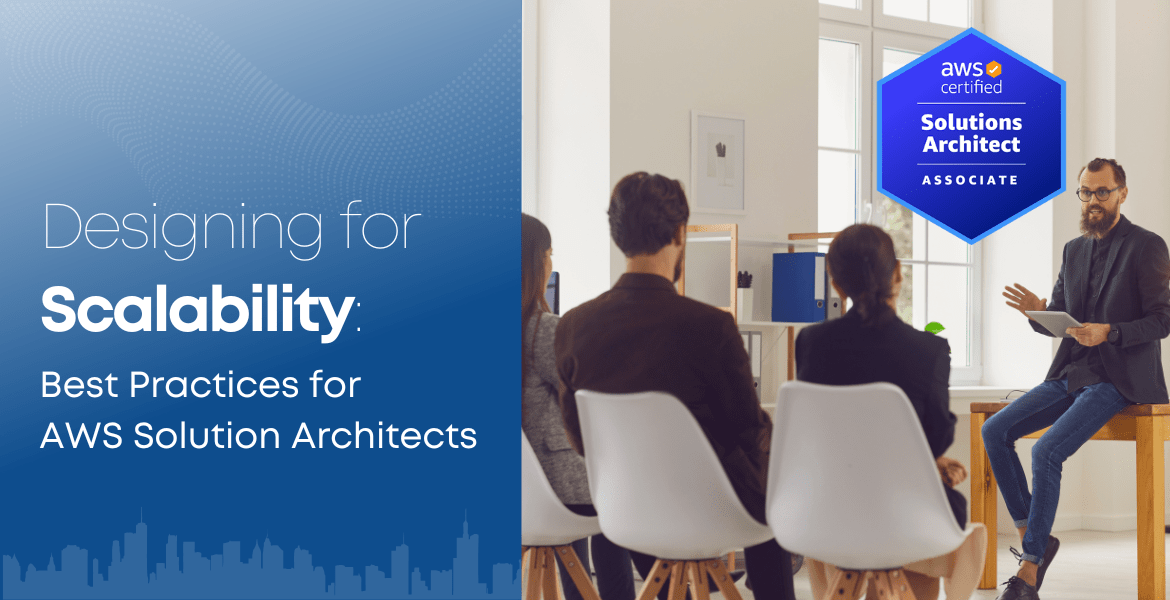Designing for Scalability: Best Practices for AWS Solution Architects
January 17, 2025 2025-01-17 16:32Designing for Scalability: Best Practices for AWS Solution Architects

Designing for Scalability: Best Practices for AWS Solution Architects
In today’s fast-paced, ever-evolving tech world, scalability has become a critical aspect of designing cloud systems. For businesses, scalability ensures that their systems can handle increased loads efficiently without sacrificing performance or user experience. As more and more organizations migrate to the cloud, AWS (Amazon Web Services) has become one of the most popular platforms. AWS offers a wide range of services, tools, and features that enable developers to create scalable, flexible, and reliable systems. However, to build scalable solutions on AWS, one needs a deep understanding of AWS architecture and services. This is where an AWS Certified Solutions Architect comes into play.
If you’re an aspiring Solution Architect AWS Certification holder, understanding the principles of scalability is essential for designing robust cloud architectures. In this blog, we’ll explore the best practices for designing scalable solutions on AWS that every solution architect should consider.
Why Scalability is Crucial in Cloud Architectures
Before we dive into the best practices, it’s important to understand what scalability is and why it’s vital. Scalability refers to a system’s ability to handle a growing amount of work, or its potential to be enlarged to accommodate that growth. In cloud computing, scalability is the capacity of a system to automatically adapt to traffic changes without manual intervention.
For businesses, scalability on AWS ensures the following:
- Cost Efficiency: Only pay for the resources you use. When demand is low, the system can scale down, saving costs. When demand is high, it scales up to maintain performance.
- High Availability: Scalable systems are usually distributed across multiple servers or regions, reducing the risk of downtime or outages.
- Performance Optimization: Scalable systems can handle more users or data without experiencing performance degradation.
- Future Growth: Scalable architectures can grow as your business and traffic grow without needing a complete overhaul.
Best Practices for Designing Scalable AWS Architectures
Designing scalable AWS architectures requires careful planning, selecting the right AWS services, and following certain best practices. Here are the key guidelines that AWS Solution Architects should follow.
1. Embrace Elasticity with Auto Scaling
One of the core features of AWS is elasticity, meaning the ability to automatically scale resources up or down based on demand. As an AWS solution architect, leveraging Auto Scaling is essential for building scalable architectures.
- EC2 Auto Scaling: With Amazon EC2 Auto Scaling, you can automatically adjust the number of EC2 instances running based on traffic patterns. This ensures that your application can handle peak traffic without over-provisioning resources.
- Application Auto Scaling: Not just limited to EC2 instances, auto-scaling can be applied to other services like Amazon DynamoDB, Amazon S3, and even ECS (Elastic Container Service) to scale your application’s components efficiently.
Auto Scaling helps maintain a balance between performance and cost-efficiency. During low traffic periods, you can reduce the number of resources, saving money, while maintaining a high level of performance during peak times.
2. Use Load Balancers for Traffic Distribution
In a scalable architecture, handling increased traffic is a major challenge. Load balancing plays a crucial role in distributing incoming traffic evenly across multiple servers or resources. AWS provides several options for load balancing.
- Elastic Load Balancer (ELB): ELB automatically distributes incoming traffic across multiple EC2 instances in one or more availability zones. It adjusts the traffic distribution based on the health and performance of your instances.
- Application Load Balancer (ALB): For more advanced use cases, ALB operates at the application layer and supports HTTP/HTTPS traffic, SSL termination, and content-based routing.
- Network Load Balancer (NLB): This works at the transport layer (Layer 4) and can handle large amounts of TCP traffic.
By using load balancers effectively, you can ensure that no single instance is overwhelmed, improving system availability and performance.
3. Design for Multi-Region Deployment
A key advantage of AWS is the ability to deploy resources across different regions. By designing for multi-region deployment, you can further enhance your architecture’s scalability, availability, and fault tolerance.
- Amazon Route 53: This is a scalable Domain Name System (DNS) service that can route users to different regions based on health checks or geographical location.
- Cross-Region Replication: Services like Amazon S3 support cross-region replication, ensuring that data is automatically copied to other regions, providing redundancy and faster access to users in different parts of the world.
This approach not only scales your system to handle large amounts of traffic but also ensures that your application is resilient to regional failures.
4. Leverage Serverless Architectures
Another way to design for scalability is by using serverless technologies. AWS offers a variety of serverless services that can automatically scale to handle high traffic loads without the need for infrastructure management. As an AWS Certified Solutions Architect, integrating serverless technologies into your designs can significantly reduce operational complexity.
- AWS Lambda: With AWS Lambda, you can run code in response to events such as changes in data or incoming HTTP requests without managing servers. Lambda automatically scales to handle the volume of incoming requests, and you only pay for the execution time.
- Amazon API Gateway: This service allows you to create, publish, and monitor RESTful APIs. It seamlessly integrates with AWS Lambda to handle incoming API requests, scaling automatically based on traffic.
Serverless architectures allow you to focus more on your application’s logic while AWS takes care of the underlying scaling automatically.
5. Use Caching to Reduce Load on Databases
As traffic grows, databases can become a bottleneck, causing slower response times and increased costs. Caching frequently accessed data can help alleviate this issue.
- Amazon ElastiCache: ElastiCache is a managed service that supports Redis and Memcached, two popular caching engines. By storing frequently requested data in memory, you can reduce database load and improve response times.
By implementing caching strategies, you reduce the number of calls to the backend systems and ensure better performance during peak traffic times.
6. Optimize Data Storage with Scalable Solutions
AWS offers several storage solutions that are designed to scale with your needs.
- Amazon S3: This highly durable and scalable object storage service is ideal for storing large amounts of unstructured data, such as images, videos, and backups. It automatically scales and provides high availability.
- Amazon DynamoDB: A fully managed NoSQL database that scales automatically to accommodate high traffic and large datasets. It’s perfect for applications that need low-latency access to data at scale.
As a Solution Architect AWS professional, it’s crucial to select the right storage solution based on the type of data and scalability requirements of your application.
7. Monitor and Optimize Continuously
Scalability isn’t just about setting up systems to handle large amounts of traffic—it’s also about monitoring and optimizing your systems over time. AWS offers a wide range of monitoring and management tools that allow you to track performance, set alerts, and make adjustments as needed.
- Amazon CloudWatch: This service helps you monitor AWS resources and applications. You can track metrics such as CPU utilization, disk I/O, and network traffic to ensure your system is running optimally.
- AWS Trusted Advisor: This tool offers real-time guidance to help you follow best practices, including those related to scalability, performance, and cost optimization.
By continuously monitoring your application’s performance and resource usage, you can proactively scale up or down to meet demand.
Conclusion
Designing scalable solutions on AWS requires a deep understanding of AWS services, the ability to integrate them into an architecture, and a focus on ensuring the system can handle increased traffic without compromising performance or cost. As an AWS Certified Solutions Architect, mastering the principles of scalability is key to building cloud solutions that meet the needs of growing businesses.
Whether you’re leveraging auto-scaling, serverless technologies, multi-region deployments, or caching solutions, the goal is always the same: to design systems that can grow with your business. By following these best practices, you’ll be well on your way to creating scalable, cost-efficient, and high-performing AWS solutions.
For those seeking to become AWS Certified Solutions Architects, mastering scalability concepts is an essential part of the certification journey. The certification exam tests your ability to design, deploy, and operate highly scalable, available, and fault-tolerant systems on AWS—making it a crucial step for those aiming to advance their cloud architecture career.







